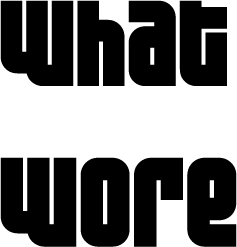What’s this project?
WhatWhoresWore is a multimedia project meant to reclaim two things: first and foremost, sex workers’ contributions to fashion throughout history, but also the nature of fashion as a valid, curated, purposeful and valuable form of self-expression.
The main component are the «paper dolls» image maps portraying different sex workers and parts of their outfit: when you hover over them, you get some information about who they were, what part of fashion did they contribute to (or who stole their aesthetic), and which social movement/class background they had. It’s crucial, in my understanding, that we contextualize the lives of these women and their socio-political achievements and the links these have to their understanding of fashion.
What do you mean whores have contributed to fashion?
This work seeks to recognise that sex workers have added to the world in multiple ways, to recognise that fashion and aesthetics are valuable forms of self-expression, and hopefully educate the public on decrim, border abolition and the need to listen to this collective.
What’s your definition of «sex worker»?
For the scope of this project, I consider anyone doing erotic labour in exchange for goods, money or influence a sex worker. This includes mistresses, courtesans, prostitutes, strippers, erotic phone operators, pornography creators (as in actors/actresses), etc.
You made a mistake. So and so is not historically accurate. Change it!
I’ll be happy to if you send me enough proof with proper referencing to hello@klashnikv.com 🙂
Why paper dolls?
The idea of using «paper dolls» comes from the notion that vanilla/mainstream culture often commodifies the experiences of marginalized collectives and chooses to wear the physical representations of these struggles (the clothes or the hairdos or the general aesthetic of the outfit) – «cutting» them out of their context (as if this didn’t cause any pain or misplacement) and placing them on top of themselves, kind of like what you do with a paper doll when you’re dressing her up. The idea to use an image map comes from my interest in developing interactive digital artefacts and also from my experience in museums, where similar displays can be seen and are a very common way to convey in-depth information about a particular piece.
Why whores and not hoes/heauxs?
Hoe/Heaux is an AAVE word and I am a very white person. As a very white person, the least I can do is not use words that don’t belong to me and whose history and context I can not understand. This project aspires to feature as many Black and Brown protagonists as possible, but that does not give me license to use said word.
Why are white women so prominently featured in this project?
It’s usually individual (and rich) white women’s histories that are easier to access and investigate, and in many cases, the only ones that have been kept. I am doing my best to research and find non-white sex workers and their contribution to fashion and hope to introduce more of them in the future.
What’s your goal?
Educating people in erotic labour history and also, hopefully, restoring sex workers voices. I also want to help the public approach the demands of this collective and start a conversation about the importance of recognising the steps of those who came before us, especially if they’ve been marginalized, erased and silenced.
I would love to continue this project onto other mediums such as videos or a podcast, as well.
Where’s this project going?
There are five paper dolls to get the project started, covering the years c.1550 – 2019, but the idea is to keep researching and updating the site with new paper dolls that will, hopefully, reflect how sex workers have affected fashion and politics since the foundation of the Roman Empire.
If you know of a sex worker who you think should be featured, please send me her name and as many details as you can gather at hello@klashnikv.com – it can be a friend, your grandmother, or an obscure historical figure.
